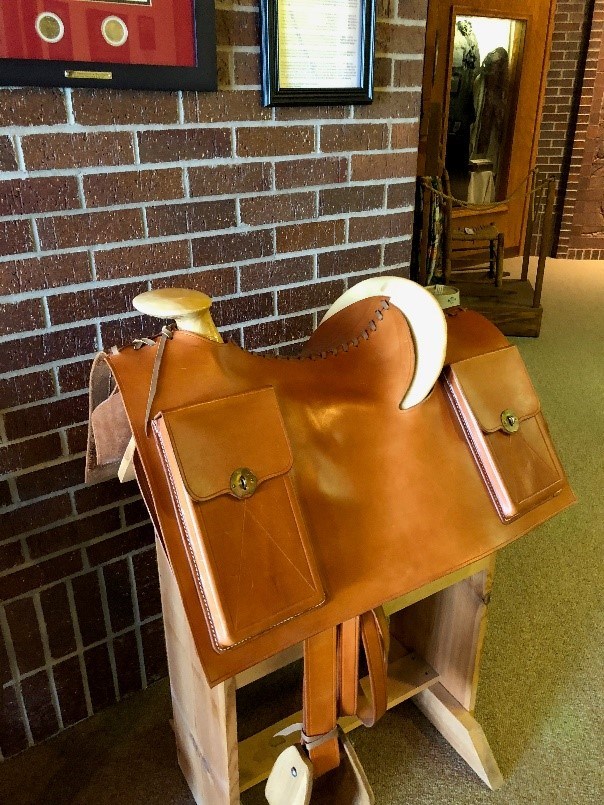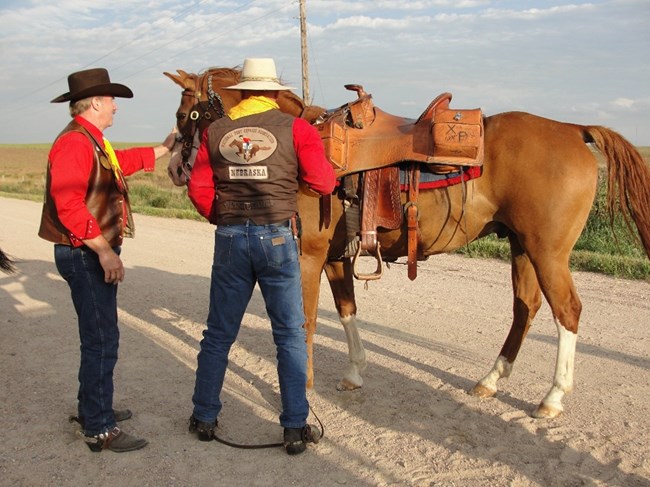Last updated: June 13, 2022
Article
Commemoration of the Pony Express
Nowadays, at the click of a button, we can get anything mailed to our homes easily and quickly. In 1860, the equivalent of modern fast shipping was sending mail via the Pony Express, which could travel cross country in 10 days. Learn more about this iconic 19th century route of communication and how the National Pony Express Association re-enacts the history every year.

The Pony Express
The Pony Express was a private mail service which ran between St. Joseph, Missouri and Sacramento, California, where horses and riders boarded a steamboat for the end of the trail at San Francisco. Beginning on April 3, 1860, the Pony Express took riders in each direction on horseback to deliver mail 1,966 miles from each terminus in 10 days. Lone riders would travel various terrain across 8 states and 190 stations on horseback for 10-15 miles before arriving at a checkpoint station and switching horses.
Riders kept the mail in the mochila (Spanish for knapsack), a leather blanket-type device designed to fit over a horse’s saddle that had four cantinas, or pockets, sewn into each corner. Once a rider dismounted from a tired horse, they would swipe off the mochila and place it on a fresh horse’s saddle at the next checkpoint. A Pony Express rider’s day was finished after several horse swaps, approximately 75 miles per day. He would place the mochila onto the final horse of his day and a new rider would continue another 75 miles in the same way.
Service along the Pony express operated for approximately 18 months, and was terminated on October 24, 1861, when the connection of the transcontinental telegraph was finalized, with the last letters reaching their destination in November 1861.

The Pony Express National Historic Trail
Beginning in the 1840s, thousands of people began to move west. California emigration began in 1841 followed by the overland rush in 1849. In 1849, the California Gold Rush prompted the largest mass emigration in American history. More than 250,000 people traveled to California in covered wagons hoping to find gold and rich farmland over the California Trail. Beginning in the early 1840s thousands of hopefuls boarded covered wagons in search of a better life in Oregon along the Oregon Trail. Mormons began their mass exodus in 1846 to Utah along what is now the Mormon Pioneer National Historic Trail.
With the nation rapidly expanding West, there was great need for east-west communication, and the Pony Express route utilized much of the same path as the aforementioned trails. When viewing the map of the National Trails System, these four national historic trails follow much of the same route through Nebraska and Wyoming.
On August 3, 1992, George H. W. Bush signed legislation authorizing the Pony Express to be added to the National Trails System. The Pony Express National Historic Trail is administered by the National Park Service. Featured on the Pony Express National Historic Trail’s official trail logo is a rider on horseback, with the iconic mochila placed over the saddle.

The Re-Ride
The National Pony Express Association (NPEA) holds an annual commemorative event called the Re-Ride, with over 750 Riders who follow more than 1,800 miles of the Pony Express National Historic Trail. The Riders will follow the route on horseback, as the original Pony Express Riders did, and carry over 1,000 letters in a mochila over 10 days. True to history, the event is held in a relay style, where an incoming Rider travels for several miles before dismounting and passing the mochila onto a new horse and Rider, who then takes off into the horizon and continues the journey.
The Re-Ride Pony Riders will travel day and night for 24 hours a day with the goal of delivering the mail. In addition to the letters, they will also be carrying a SPOT GPS tracker so followers of the event can see the progress of the journey via an NPS map. The GPS will “ping” every 5 minutes and update the Pony Rider icon on Pony Express Re-Ride map.
The National Park Service supports the annual Pony Express Re-Ride through financial and technical support. Follow along by checking out the Pony Express Re-Ride map to see the progress of the Pony Riders as they deliver mail along the Pony Express National Historic Trail!
For more information about NPEA and the Pony Express Re-Ride, click here.
Visit the Pony Express National Historic Trail website for information about the Trail.
Visit the National Trails System website for more information about national historic trails.
Sources:
National Pony Express Association, https://nationalponyexpress.org/. Accessed May 2022.
Pony Express National Historic Trail, https://www.nps.gov/poex/index.htm. Accessed May 2022.
